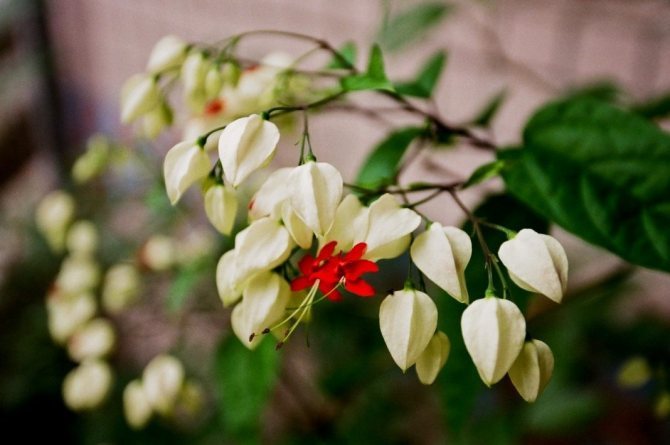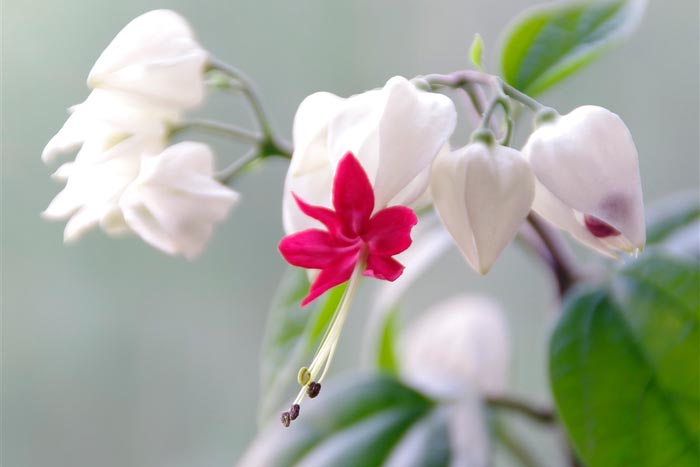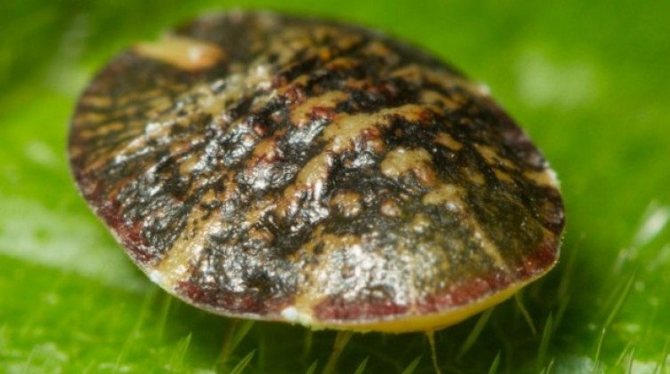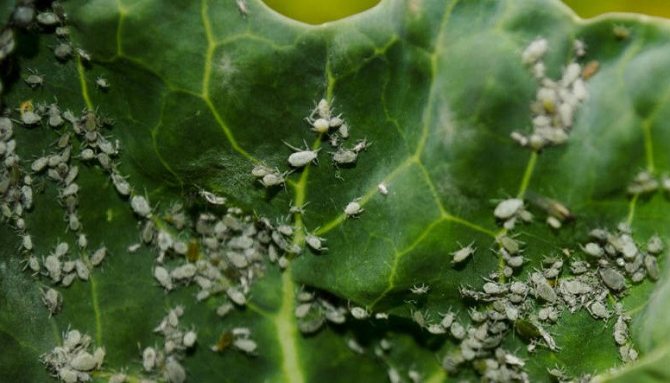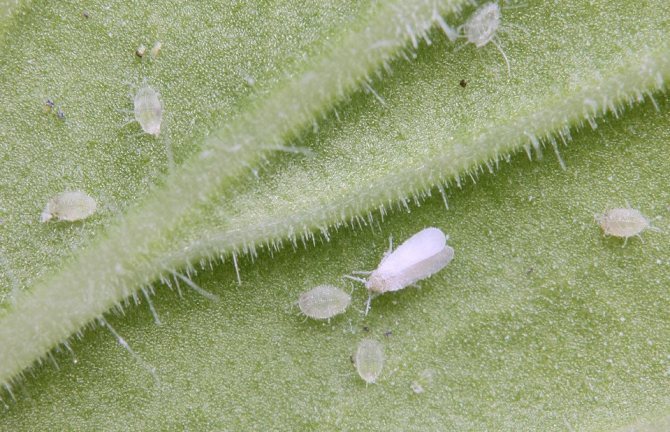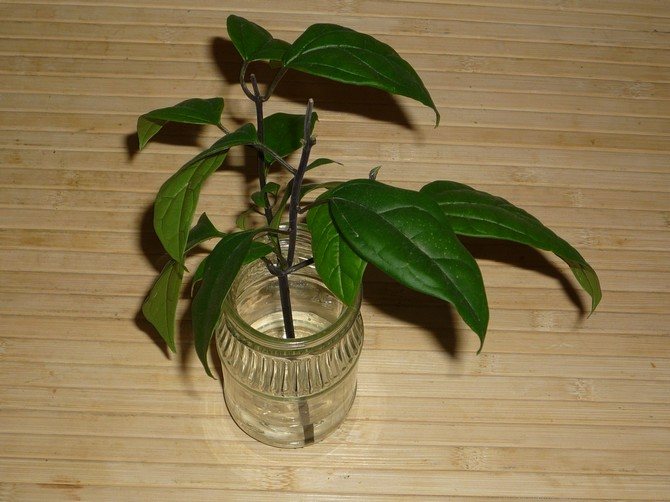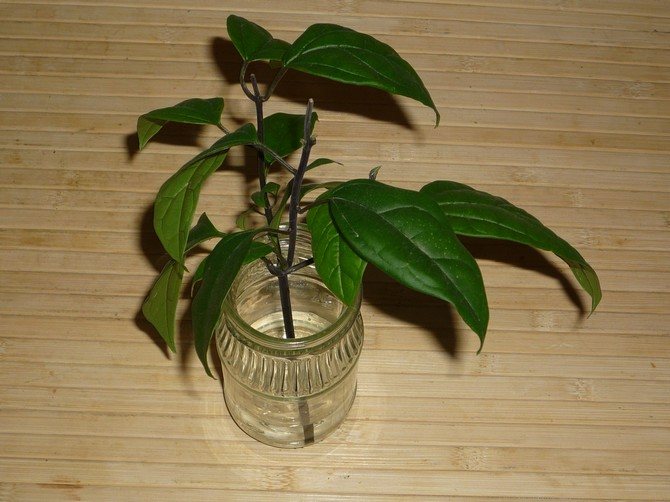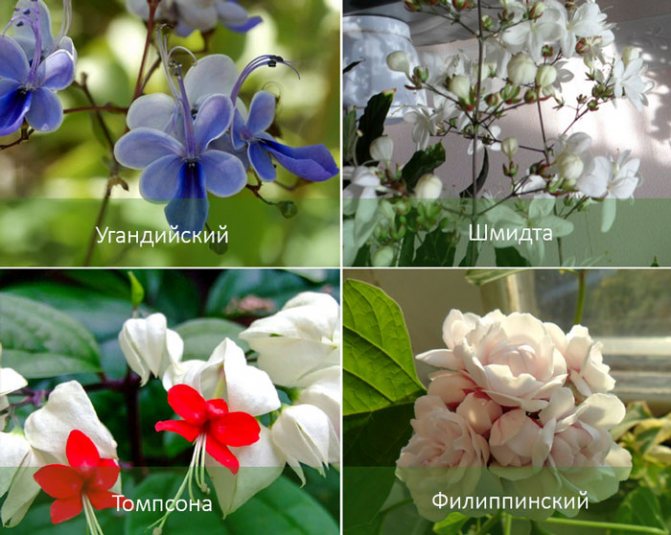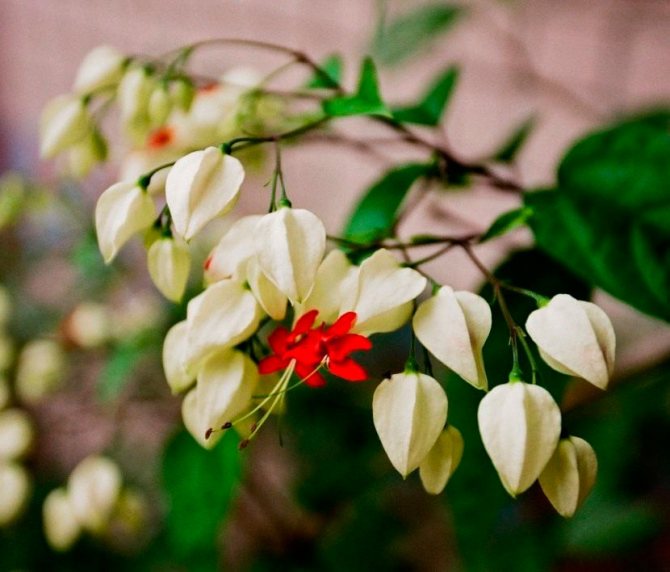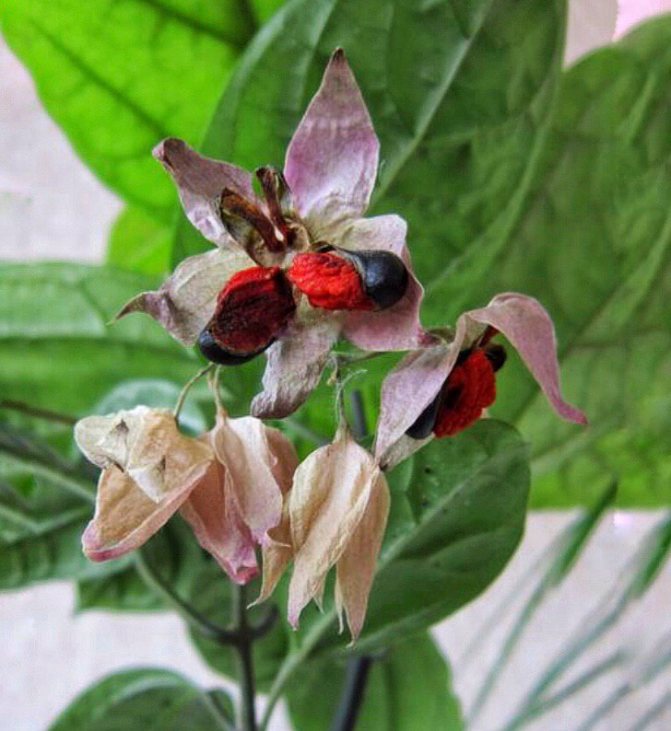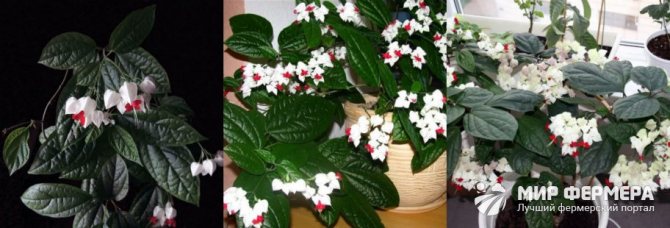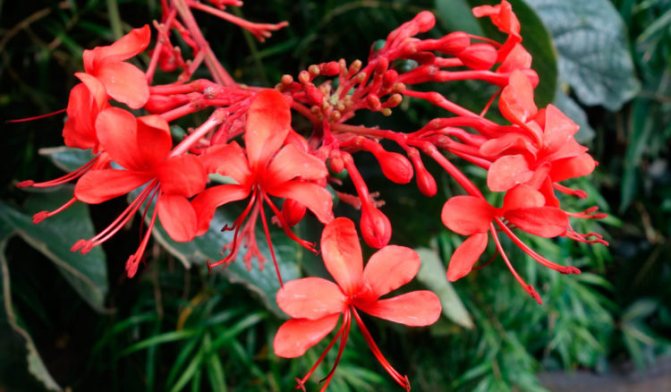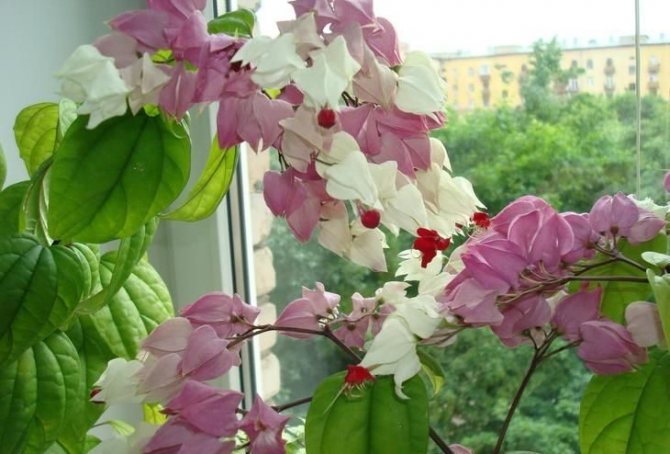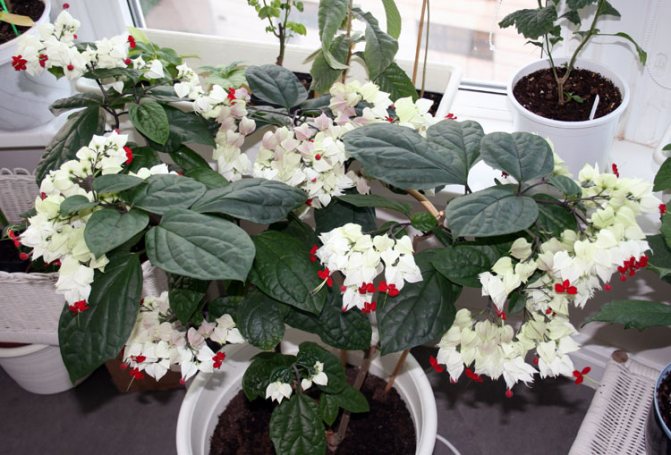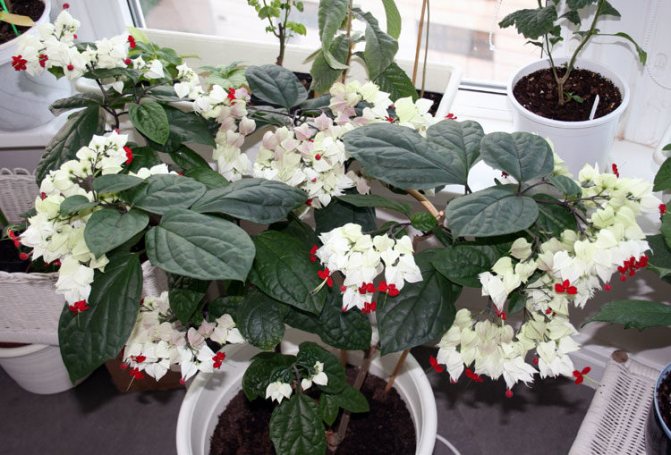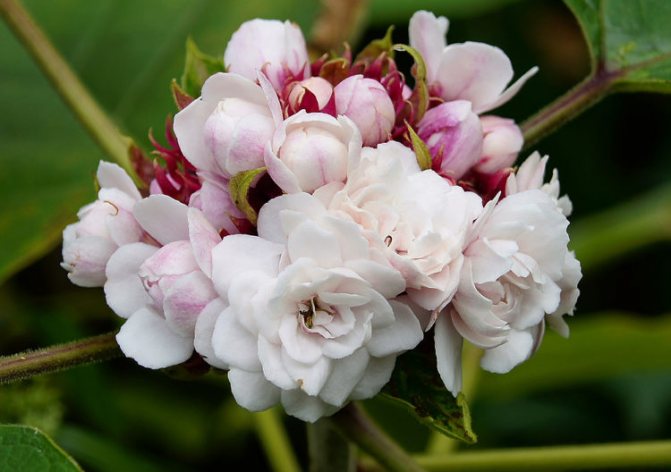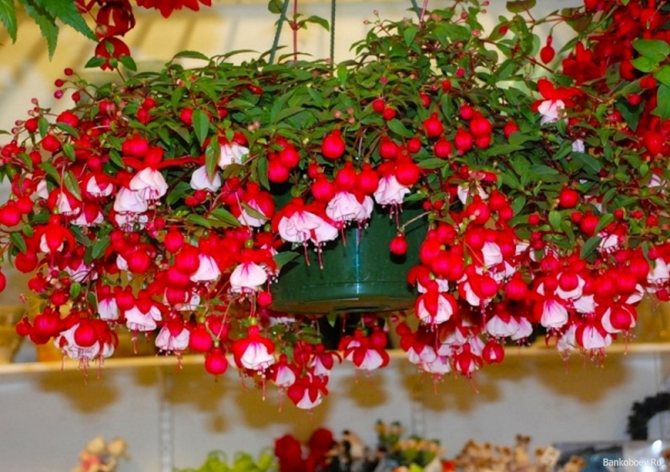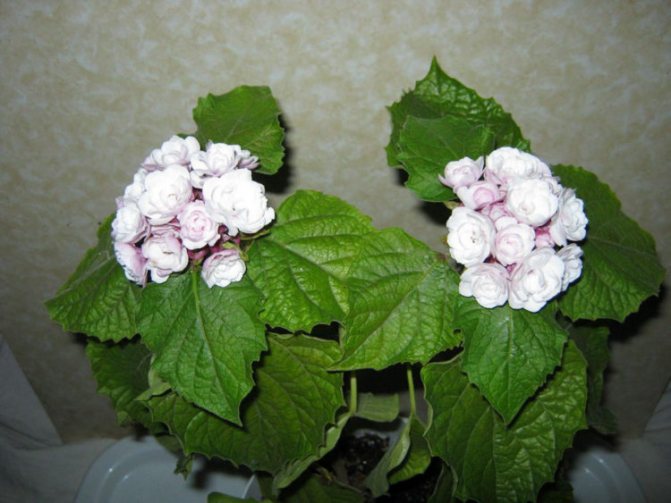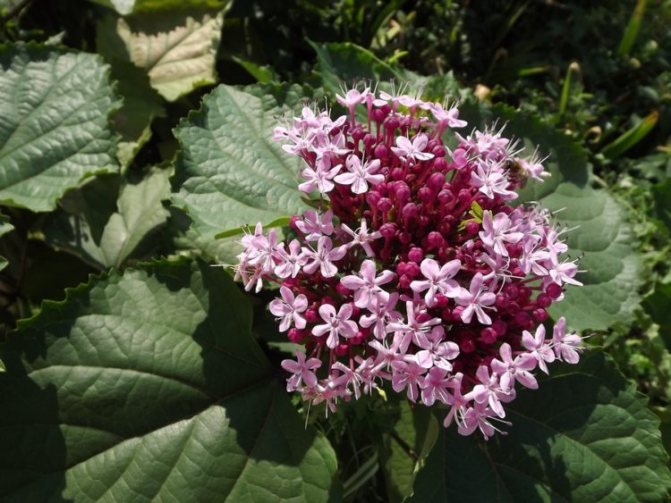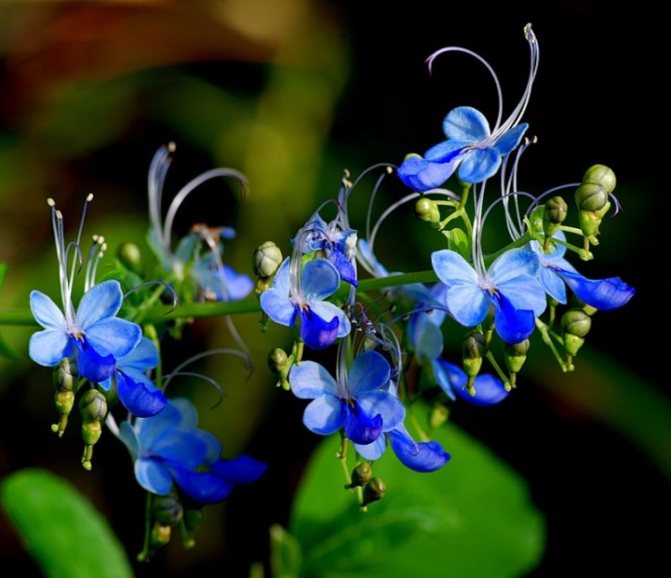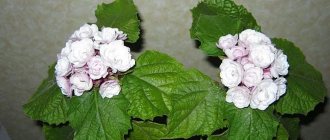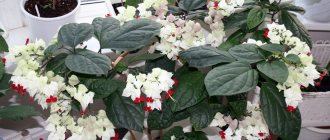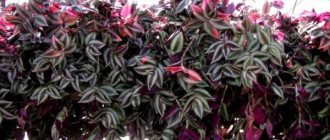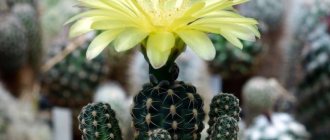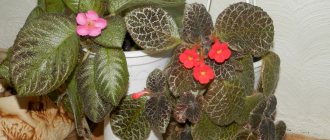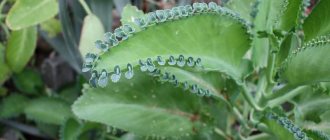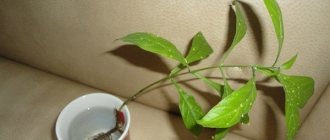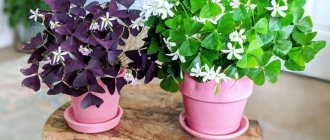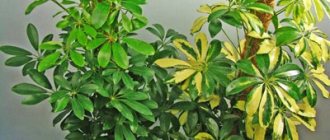Thompson's Clerodendrum is a spectacular houseplant that is both an interior decoration and a good omen. The plant is popularly called "pure love", as well as "the tree of fate", and its appearance in the house signifies good luck, happiness, the beginning of good times for the whole family. We will learn how to care for a clerodendrum so that it grows well, develops, blooms and does not get sick.
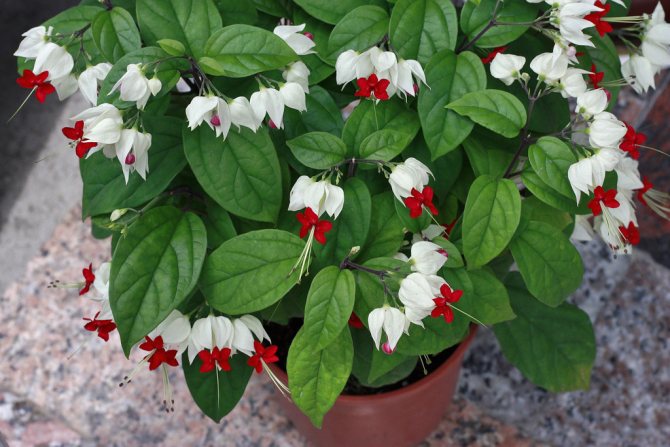
General information
This flower is a tropical liana native to equatorial Africa. There, Thompson's Clerodendrum grows right in the jungle. It is interesting that in tropical forests twilight always reigns, and this plant is extremely photophilous. Therefore, it always weaves along the trunks of trees, thus reaching the sun's rays.
I must say that this flower has changed in some way in comparison with its African counterpart over the years. Now he no longer has a solid trunk, and his shoots have become smooth, thin and elastic. When kept at home, clerodendrum needs an artificial support along which it will trail, pleasing the eye with its abundant flowering.
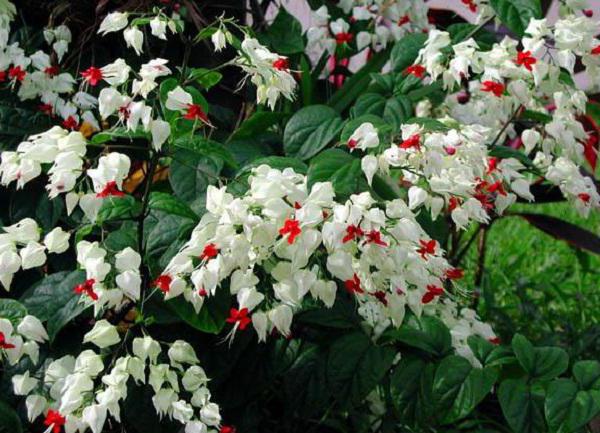

This is a plant with dense green leaves, slightly grooved at the edges. Nowadays, Clerodendrum can be bought in almost any specialty store. The flowers offered there always grow in the form of a bush, which, you see, is quite convenient for location in a city apartment. But unfortunately, this form will not last long. The fact is that in flower shops, plants are specially fed with growth hormones, but after their effect is over, the clerodendrum will immediately turn into a vine that can trail along the support.
If desired, such a plant can be turned into a solid flowering carpet. However, this will take a little work: the flower will need to be constantly cut and pinched. It will begin to branch, and beautiful and dense shoots will appear on it.
a brief description of
Thompson's Clerodendrum is an evergreen fast-growing vine. The plant belongs to the species of deciduous, vervain family, found naturally on the coasts of South Africa. This is the most popular type of clerodendrum in home growing conditions: there are about 450 species in total.
Clerodendrum Thompson is distinguished by extremely flexible shoots, slightly curling. In height, such an shoot can reach up to 4 meters, however, in room conditions, a flower is usually not allowed to grow to such an extent. In an adult specimen, the shoots become lignified over time. The leaves have shortened petioles, their shade is emerald green, very beautiful, bright. The veins on the surface stand out noticeably, while the shape of the leaves is unusual, heart-shaped.
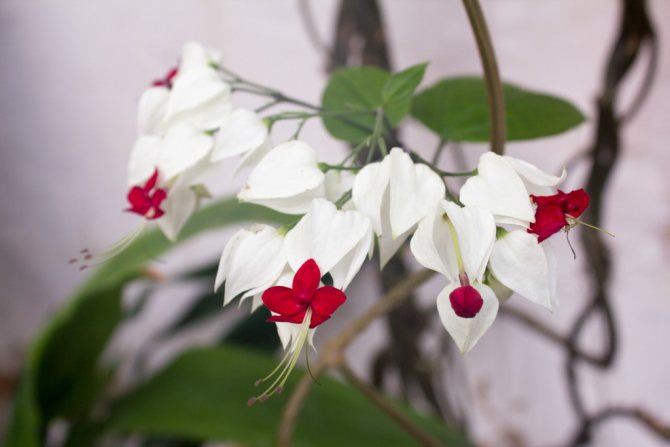

Thompson's clerodendrum blooms for a long time and very luxuriantly, and twice a year: in spring and autumn. The buds are located at the ends of elongated peduncles and are collected in beautiful cluster-like inflorescences. Each individual flower has five petals, in the inflorescences the buds are located in 6-22 pieces. Inside the flower is a butterfly-shaped corolla. The stamens are elongated and, in their own way, also give the plant a decorative effect (see photo).
The petals are white, after their flowering, a round fruit is formed, resembling physalis. The seed capsule has a red or orange tint. Only one seed is hidden inside it.
First breeding method
Clerodendrum Thompson, reproduction of which is carried out in two ways, can be attributed to rather unpretentious plants. One of the methods is planting cuttings in the soil, the second is seeds. At home, the first method is most often used. To do this, take the tops of the shoots or stem cuttings and plant them in pre-prepared soil. In this case, the temperature in the room should be at least 22 and not more than 25 ⁰C.
Preparing the soil for planting is done in advance. To do this, take equal amounts of sod land, sand and humus. Usually, two or three cuttings are planted in one pot at once, after which they are covered with plastic wrap and placed in a warm place. In order for the young Clerodendrum to feel good, do not forget about the daily airing of the container and spraying the plant from the sprayer. In addition, the condensation formed on the film must be regularly removed, and the liana itself must be fed with fertilizers from time to time.
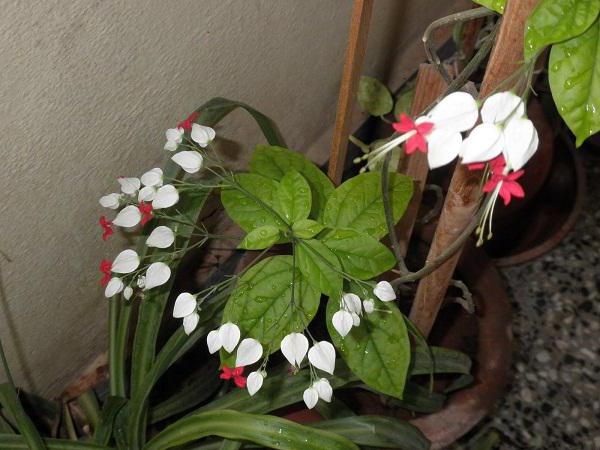

When new shoots and leaves appear, the plastic wrap should be gradually removed, every day increasing the time the vines are in the fresh air. So the plant adapts well to room temperature. The established young Clerodendrum is transplanted into separate pots after a year, since each such procedure is a great stress for the plant.
Liana Clerodendrum Thompson at home can also be bred using cuttings placed in water, while the liquid must be filtered. The lower leaves that have come into contact with water must be removed, otherwise they will begin to rot, and this will inevitably cause the appearance and development of not only fungi, but also other bacteria. As soon as the cuttings release the roots, they are immediately planted in the ground as described above.
Pests
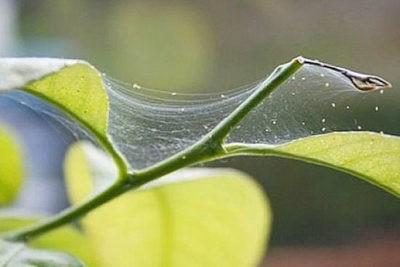

Spider mite - there is a slightly noticeable cobweb on the leaves, and the back of the leaf has white dots. For treatment, spray once every 3 days with Actellik solution (1 ampoule per 1 liter of water). Repeat 3-4 times. As a preventive measure, maintain the required humidity level, do not forget to regularly and abundantly spray, once a month, arrange a shower with soapy water.- Whitefly - the leaf is covered with a white shiny bloom, an insect can be seen on the back of the leaf. Control measures and preventive measures as for spider mites.
- Shield - leaves quickly wither, brown pustules of insects on the stems are visible. Scrape off the scabbards, treat the plant with soapy water, rub with alcohol. Treat with the drug and you need to repeat it every seven days for a month.
- Mealybug - the growth of the plant stops, it sheds its leaves, dirty white balls, similar to cotton wool, appear on the leaves and shoots. It is necessary to wipe the leaves and shoots with alcohol, spray with insecticides. For prevention, control humidity and spray.
If you have already decided to grow clerodendrum or are just planning to start, we advise you to familiarize yourself with our materials about other types of this plant, namely about the varieties:
- Specialozum;
- the most beautiful;
- Bunge;
- Ugandan;
- inerma;
- Wallich or Prospero;
- brilliant;
- Philippine.
Second breeding method
You can also grow clerodendrum at home from seeds. Usually they are purchased in specialized stores or assembled on their own. If you follow the recommendations of experts, you can grow luxurious Thompson's Clerodendrum from seeds. It is recommended to collect them only in the spring, since at this time the vine begins its active growth.
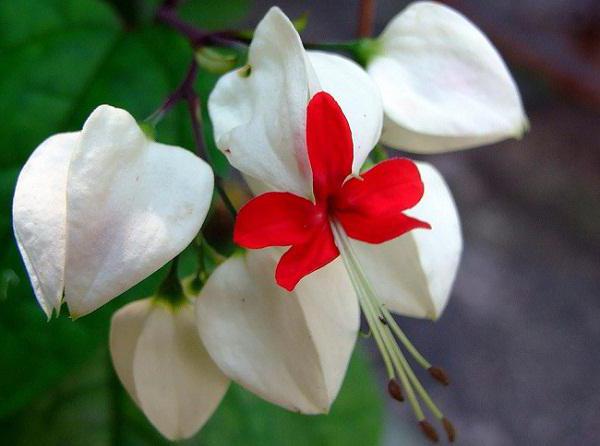

Sowing is usually done either in March or April. It should be remembered that too deeply planted seed may not break through to the surface.After the end of sowing, the box must be covered with foil and left in a warm room, where the temperature should be at least 24 ⁰C. As soon as the plants are a few centimeters long, they are filtered, i.e. painful and frail shoots are removed so that they do not interfere with the development of stronger shoots.
The Clerodendrum Thompson flower can be planted in separate containers no earlier than 3 weeks later. In the future, they are treated in the same way as when propagating by cuttings. As it turned out, growing this flower from seeds is not difficult at all.
Growing features
In home content, any shape of Clerodendrum can be created by pruning.
- Liana - with proper care in the apartment, a sufficiently long (up to 3 meters) liana can grow, it is necessary to form it and stimulate abundant flowering by pruning and be sure to provide support.
- Bush - in the spring, as soon as the greens begin to bloom, the branches (young ones) must be cut off. To form a trunk, you need to carefully clean one of the strongest shoots from unnecessary branches (from below); when it grows to 50 cm, you should pinch and also pinch all new growing branches to get a lush crown.
TIP: You need to spray a home flower only in the evening, before sunset (to match the biological clock) - at this time dew falls in its natural habitat.
Plant transplant
Clerodendrum Thompson, depending on the specific variety, sheds leaves in the cold season either partially or completely. That is why this plant needs to be transplanted into a new pot, as well as warm, in order to gain strength. It should be noted that the container for it should be spacious. It is necessary to transplant a flower into a substrate, which includes peat and greenhouse soil. To do this, take two parts of such a mixture and add coarse sand to it. Then everything is thoroughly mixed and poured into a pot, into which the flower will be transplanted. In addition, good drainage must be placed on the bottom of the container.
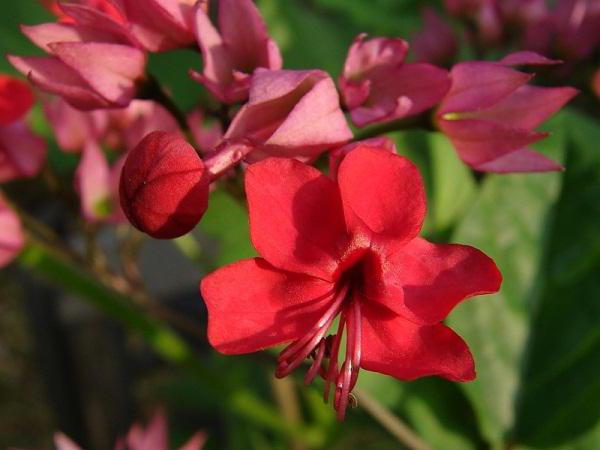

Thompson's clerodendrum, which is easy to prune, can be shaped in different ways. Since this plant is a liana, it easily twists around any support. For example, you can pull several special threads, but this will mean that in this case it will be impossible to rearrange the flower pot to another place.
Lighting and temperature control
As mentioned above, the abundance of sunlight is exactly what Thompson's clerodendrum loves. Caring for this plant at home will require you to organize decent lighting for it. But it should be remembered that direct sunlight can harm the flower. The best place for it to grow would be a window on the west or east side of the house. If you place it from the north, then it will not give a lush flowering, since it will not have enough sunlight.


As you know, Clerodendrum blooms during the warm season, when the temperature ranges from 18 to 25 ⁰C. With the onset of the winter months, the plant should rest and recuperate, so it is recommended to place it in a cool place. If the clerodendrum is left warm for this period, then in the spring it may not bloom at all.
Botanical description
In the natural environment, the liana grows up to 4 meters in length, in the home - up to two. Long flowering is inherent in the plant, up to 6 months, starting from March - April and ending in September - October.
| Stem | Curly, woody liana |
| Leaf shape | Oval, grooved along the veins, up to 12 cm in length |
| Leaf color | Green |
| Flower shape | Bracts - in the form of inverted cups or bells up to 3 cm in diameter.Flowers - in the form of a five-lobed corolla with stamens |
| Flower color | Bracts - white, turn pink over time, turn lilac; flowers - bright red, eventually become dark cherry |
| Fruit shape | Oval, length about 1 cm |
| Fruit color | Orange |
Clerodendrum Thompson is native to the western regions of the African continent. The evergreen vine is notable for its fast growth. Refers to the species of deciduous, vervain family. The Latin name is Clerodendrum thomsoniae.
The subspecies is variegated, which means that in the cellular composition of the plant there are mutated cells that are not inherent in other representatives of the species. The mutation manifests itself in the pigmentation of the leaves and flowers of the shrub. Individual pigments have different colors, but most often they are red.
The stem is remarkable for its plasticity. The height of an adult bush often exceeds the mark of 4 m. With age, the stem becomes crusty. A plant with lignified shoots is considered elderly.
The leaves of the bush are recognized by the short connecting leg, cross-arrangement, malachite coloring. Plus, the veins of the leaf form a catchy pattern, which makes it easy to distinguish the Thompson subspecies from fellows.
The appearance and location of the veins give the sheet a similarity to a sewn-through canvas. The edges of the leaf are not sharp. The general shape is oval with oblong edges. The average length does not exceed 13 cm.
The traditional arrangement for the buds is the core of the axils of the peduncles, which are recognized by their oblong shape. The classic flower arrangement format for the West African shrub is racemose inflorescences. One bouquet has 6 to 20-22 flowers with 5 leaves.
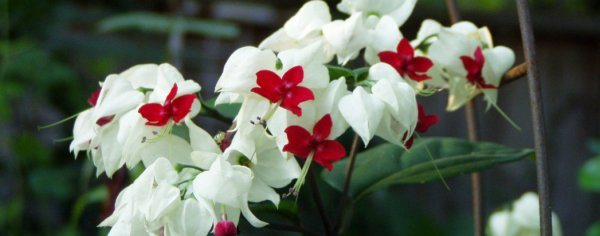

The flower receptacle resembles a bell with a maximum diameter of 3 mm. In the bell there is a platform on which stamens about 3 cm high grow.
In the intermediate period between the end of flowering and the onset of winter rest, orange fruits appear 1 cm long. Each fruit carries a seed.
Watering and spraying
In order for the flowering to be abundant, this plant needs good moisture. Watering should be done with soft and well-settled water. Only in this case can the well-being of such a flower as Thompson's clerodendrum be guaranteed.
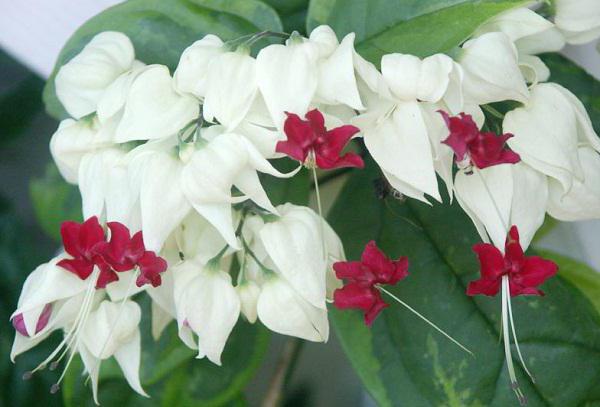

Caring for him includes both regular watering and spraying. The plant can wither even from dry indoor air. An ideal humidification option is a tray with wet pebbles, on which a flower pot is placed. As well as for irrigation, water for spraying is used exclusively with settled water. It is very important to note that this plant is categorically not recommended to be placed near batteries and other heating devices.
How to care
Consider all the nuances of caring for Madame Thompson's clerodendrum.
Watering
It is important not to allow waterlogging of the substrate, since stagnation is contraindicated for clerodendrum. Root decay is a dangerous consequence that happens due to regular waterlogging. Water the flower only after the substrate dries noticeably on top.
However, proper care also means avoiding drought: especially when the flower is actively growing. In winter, watering can be reduced significantly, moistening the soil only when necessary. Keep one simple rule in mind when caring for clerodendrum: the lower the air temperature in the room, the less water the flower needs.
Water Thompson's Clerodendrum with only warm and soft water. Water from the tap must first be defended before being used for irrigation.
Top dressing
Properly applied fertilizers will help the clerodendrum bloom longer and more luxuriantly. The recommended frequency of feeding is once every 2 weeks. Fertilizers are usually applied during the growing season: that is, from early March to mid-late September. By autumn, the amount and frequency of fertilization are reduced, and in winter they are not fed at all.
Alternate mineral supplements with organic humic ones.Of the minerals, the complex composition of "Agricola" is optimal: it should be used according to the instructions. From humic plants "FlorHumate" is suitable for flowering ornamental plants.
Minerals supply the plant with all the necessary substances for normal life. Organic dressings saturate the soil with humus, make the soil more fertile, and improve its biologically active properties.
Attention: be careful with nitrogenous fertilizing, since nitrogen promotes the formation of leaves, but at the expense of flowering
Pruning
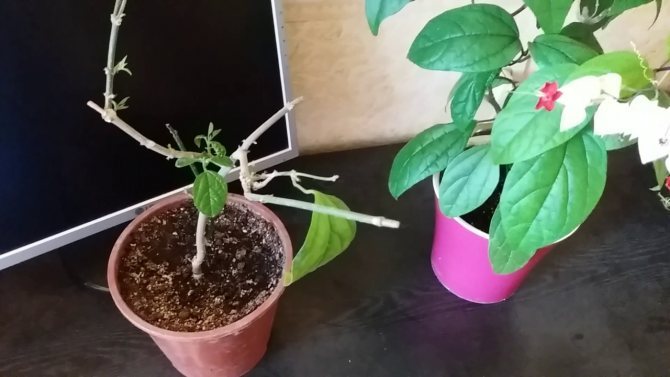

With the help of competent pruning, you can form anything from a clerodendrum: even a climbing liana, even a compact shrub, even a small pretty tree.
When clerodendrum reaches adulthood, it needs regular pruning. The procedure helps to maintain the shape of the plant, and also provokes it to abundant long flowering. The optimal time is in spring, when the sap flow begins in the tissues of the flower. Usually the shoots are shortened by one third. Before shaping pruning, do not forget to carry out a sanitary one: remove all broken, diseased, thickening branches.
Young flowers cannot be pruned. But you can pinch the tops of the shoots so that the clerodendrum branches more strongly.
After the clerodendrum has bloomed for the second time in a season (usually in early September), all peduncles should be cut off. At the same time, the frequency of top dressing and watering decreases. Thus, the plant prepares for winter.
Important: in addition to the main pruning, you should also regularly pluck out the young root shoots that appear at the base of the trunk.
Transfer
The procedure is carried out in early spring before active growth begins. As a rule, the transplant is carried out in connection with the outgrowth of the old pot by the flower. Choose a new container larger than the previous one, but not by much.
Young clerodendrum is transplanted annually, as it grows very quickly. In adulthood, plants are transplanted every two to three years: a gentle transfer method is optimal.
Dormant period
Thompson's Clerodendrum, like most of its species, needs a dormant period. This period begins in November-December and lasts approximately until March.
Top dressing and watering at this time are rare. You can stop applying fertilizers altogether, but watering is still sometimes necessary. It is imperative to keep the plant in cool conditions in winter: this is the key to the future lush flowering of clerodendrum and its general well-being.
Care after purchase
When you have just purchased Thompson's Clerodendrum and brought it home, place the flower pot temporarily separately from other plants. This is the so-called quarantine, which helps to avoid contamination of home flowers by infections and pests brought from another place.
Place the plant in a bright, but protected area from direct sun. Watering at first should be extremely moderate: keep the earthen coma constant, but not excessive.
As for the temperature, for the early adaptation of the flower, the range from +18 to +20 degrees is optimal: not hot, but not cold either. There is no need to add top dressing in the first month after purchase.
What if Clerodendrum is not blooming?
There are several reasons that explain the lack of flowers on the plant. For example, a pot that is too big. In this case, the root system does not receive the amount of nutrients it needs. Fixing this problem is simple - you just need to change the large pot for a smaller one.
The next reason may be a lack of light. For lush flowering, clerodendrum must be installed on the west or east window. In order for the plant to have a good rest, during this period you should not fertilize it at all, and also water it too often.
Remember that any flowers must be properly cared for. In order to find the cause of the problem that has arisen, it is necessary to carefully analyze both the conditions for keeping this plant and the technology for caring for it. By comparing all the data, you can easily find the true reason for the lack of flowering.
Varieties for an apartment
At least 300 plant species have been described, but only a few are found in the homes of florists. There are clerodendrum, losing leaves and requiring a dormant period in winter, and there are evergreen representatives.
As the most spectacular are noted:
- Clerodendrum Thomson. It was he who was noticed by the missionaries. Bright red buds surrounded by white perianths-boxes create a stunning, magical picture. The variety blooms in late spring. In a room, it is a small tree or shrub.
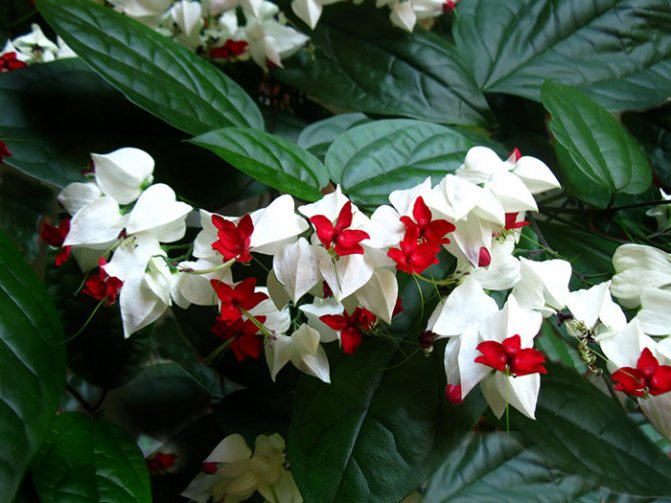

Clerodendrum Thomson
- Clerodendrum specialosum or fine. Often grown as an ampelous plant. The flowers are red, and the bracts are of a delicate purple hue. If the "beautiful" is properly looked after, the plant pleases with flowering all year round.
- Wallich's Clerodendrum or "nodding jasmine". Against the background of dark leaves, huge clusters of white flowers with long stamens protruding strongly beyond the edge of the calyx hang. With the opening of the buds, the shoots become heavy and periodically hang down, as if nodding. It is this feature that is noted in the title. The variety is grown by gardeners in the form of a shrub.


Wallich's Clerodendrum
- Clerodendrum Ugandan. The plant is endowed with thin, long shoots with oval-shaped leaves. Flowers with blue petals and the same color of stamens. Under indoor conditions, it is cultivated in ampelous form.
- Clerodendrum Filipino. It differs in the shape of an inflorescence in the form of a ball and cream-colored buds resembling small roses. Flowering is observed almost all year round. It emits a pleasant, rich aroma.
- Clerodendrum Bunge. Star-shaped purple flowers with long stamens are collected in globular inflorescences. Some amateurs compare them to bright fireworks. It grows like a shrub or a small tree.
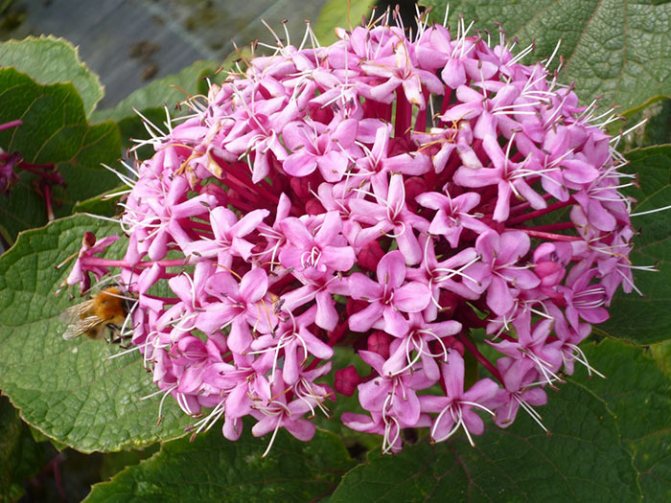

Bunge
- Clerodendrum Inerme or thornless. The shrub is densely covered with white flowers. It is distinguished by the beginning of budding at the end of autumn.
- Clerodendrum Schmidt. White, fragrant inflorescence brushes, reaching a length of half a meter or more, hang down in a cascade. The look is compared to the bride's veil. It blooms 2 times in winter.
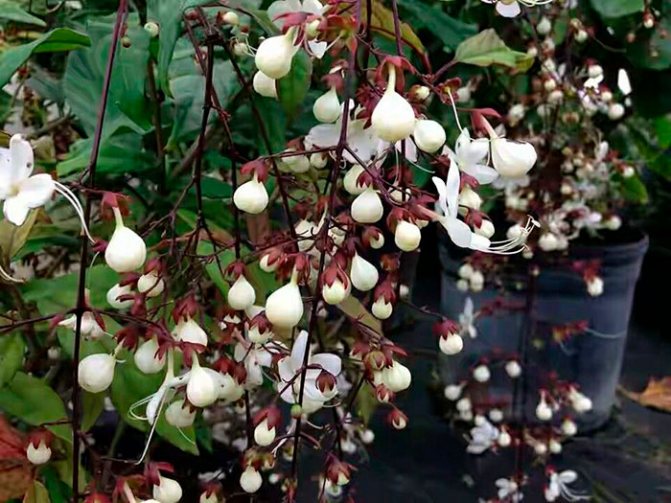

Schmidt
Now there are many varieties with double buds and variegated leaves.
Attention! The nature conceived the similarity of flowers to moths. Insects, thinking that a related individual is in front of them, sit on the "bait" and transfer pollen from one plant to another, thereby ensuring high-quality fertilization.

